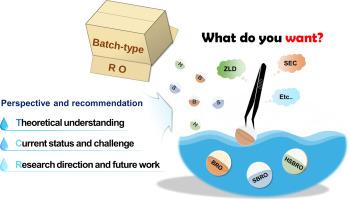当前批处理式RO系统的实际实施和挑战以及未来潜力:综述
IF 9.8
1区 工程技术
Q1 ENGINEERING, CHEMICAL
引用次数: 0
摘要
气候变化和人口增长加剧了全球水危机,需要有效的海水淡化技术来确保可持续的水管理。到2050年,预计全球60%以上的人口将面临水资源短缺,而到2022年,只有57%的人口能够获得安全的卫生设施服务。反渗透(RO)已成为最有效的海水淡化方法,具有高盐去除率(~ 99%)和有利的能源效率(海水2.0-5.5 kWh/m3)。尽管高回收率和混合RO系统等创新技术提高了性能,但根据给水条件和能源限制选择最佳的海水淡化技术仍然是一个重大挑战。在这些技术中,间歇式RO以其潜在的节能和操作优势而备受关注。然而,尽管有这些好处,仍然缺乏在不同条件下设计批量RO配置和优先级的系统框架。本文评估了各种批量RO配置,分析了它们的最新进展和理论基础,并提出了一套观点和建议,以确定适当的操作条件,并根据具体的技术和政策驱动因素选择最佳技术。本文章由计算机程序翻译,如有差异,请以英文原文为准。

Practical implementation and challenges of current batch-type RO systems and future potential: A review
The global water crisis, intensified by climate change and population growth, necessitates efficient desalination technologies to ensure sustainable water management. By 2050, over 60 % of the world's population is expected to face water shortages, while in 2022, only 57 % had access to safe sanitation services. Reverse osmosis (RO) has emerged as the most effective desalination method, offering high salt rejection (∼99 %) and favorable energy efficiency (2.0–5.5 kWh/m3 for seawater). Although innovations such as high-recovery and hybrid RO systems have improved performance, selecting the optimal desalination technology based on feedwater conditions and energy constraints remains a significant challenge. Among these technologies, batch-type RO has attracted attention for its potential energy savings and operational advantages. However, despite these benefits, a systematic framework for designing and prioritizing batch-type RO configurations under varying conditions remains lacking. This review evaluates various batch-type RO configurations, analyzes their recent advancements and theoretical underpinnings, and proposes a perspective and set of recommendations for identifying appropriate operational conditions and selecting optimal technologies based on specific technical and policy-driven considerations.
求助全文
通过发布文献求助,成功后即可免费获取论文全文。
去求助
来源期刊

Desalination
工程技术-工程:化工
CiteScore
14.60
自引率
20.20%
发文量
619
审稿时长
41 days
期刊介绍:
Desalination is a scholarly journal that focuses on the field of desalination materials, processes, and associated technologies. It encompasses a wide range of disciplines and aims to publish exceptional papers in this area.
The journal invites submissions that explicitly revolve around water desalting and its applications to various sources such as seawater, groundwater, and wastewater. It particularly encourages research on diverse desalination methods including thermal, membrane, sorption, and hybrid processes.
By providing a platform for innovative studies, Desalination aims to advance the understanding and development of desalination technologies, promoting sustainable solutions for water scarcity challenges.
 求助内容:
求助内容: 应助结果提醒方式:
应助结果提醒方式:


